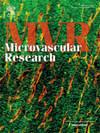Nailfold video capillaroscopy predicts severe progression at three years in systemic sclerosis: Results from SCLEROCAP study
IF 2.7
4区 医学
Q2 PERIPHERAL VASCULAR DISEASE
引用次数: 0
Abstract
Objectives
Systemic sclerosis (SSc) has a variable evolution but may be life-threatening owing to pulmonary, cardiac or renal involvement. Nailfold video capillaroscopy (NVC) is abnormal early in the disease and is crucial for diagnosis. An association between subtypes of scleroderma pattern and disease progression has been suggested. Therefore, we conducted a prospective study to assess whether capillaroscopy can identify SSc patients at risk of progression.
Methods
SCLEROCAP was a prospective multicentre observational study that included patients with a diagnosis of SSc followed up for three years. Each patient had yearly standard evaluation and NVC. Images were read by two observers blinded from each other and were classified into subtypes (2 for Maricq's and 3 for Cutolo's classification). Severe progression was defined as cardiac, pulmonary or renal involvement or progression and was assessed by a validation committee.
Results
Three hundred and eighty-seven patients were included of whom 369 were followed-up and 53 (14 %) had severe progression. A simple model using Cutolo's capillaroscopic late stage, short duration of disease and age was as powerful in predicting severe progression as a model using all the parameters known to be predictive (AUC[95 %CI] 0.74[0.67–0.82] vs 0.73[0.64–0.77] respectively.
Conclusion
NVC is a predictor of severe progression and might be helpful for early therapeutic decisions in patients with SSc.
甲襞视频毛细血管镜可预测系统性硬化症三年后的严重进展:来自clerocap研究的结果。
目的:系统性硬化症(SSc)有一个可变的演变,但可能危及生命,由于肺,心脏或肾脏受累。甲襞视频毛细血管镜检查(NVC)在疾病早期异常,对诊断至关重要。已提出硬皮病亚型模式与疾病进展之间的关联。因此,我们进行了一项前瞻性研究,以评估毛细管镜检查是否可以识别有进展风险的SSc患者。方法:scclerocap是一项前瞻性多中心观察性研究,纳入了诊断为SSc的患者,随访三年。每位患者每年进行标准评估和NVC。图像由两名相互盲视的观察者阅读,并分为亚型(Maricq分类为2,Cutolo分类为3)。严重进展定义为心脏、肺或肾脏受累或进展,并由验证委员会评估。结果:共纳入387例患者,随访369例,病情严重进展53例(14% %)。使用Cutolo毛细管镜的简单模型预测晚期、疾病持续时间短和年龄与使用所有已知预测参数的模型一样有效(AUC[95 %CI] 0.74[0.67-0.82] vs 0.73[0.64-0.77])。结论:NVC是严重进展的预测因子,可能有助于SSc患者的早期治疗决策。
本文章由计算机程序翻译,如有差异,请以英文原文为准。
求助全文
约1分钟内获得全文
求助全文
来源期刊

Microvascular research
医学-外周血管病
CiteScore
6.00
自引率
3.20%
发文量
158
审稿时长
43 days
期刊介绍:
Microvascular Research is dedicated to the dissemination of fundamental information related to the microvascular field. Full-length articles presenting the results of original research and brief communications are featured.
Research Areas include:
• Angiogenesis
• Biochemistry
• Bioengineering
• Biomathematics
• Biophysics
• Cancer
• Circulatory homeostasis
• Comparative physiology
• Drug delivery
• Neuropharmacology
• Microvascular pathology
• Rheology
• Tissue Engineering.
 求助内容:
求助内容: 应助结果提醒方式:
应助结果提醒方式:


